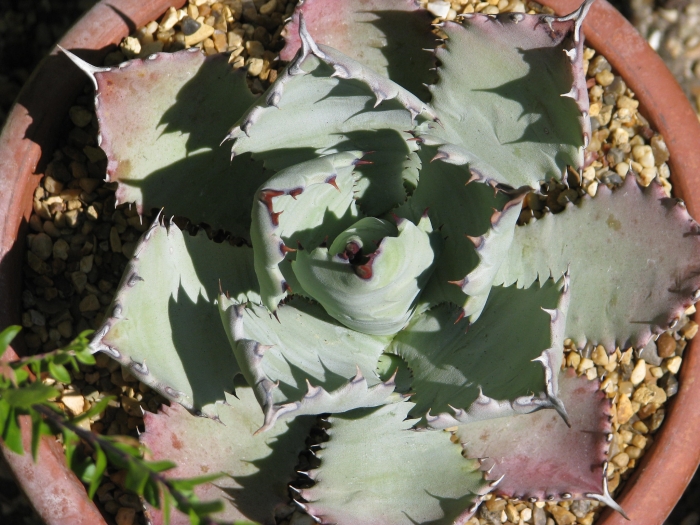Maguey Chato
(Agave guadalajarana)
Maguey Chato (Agave guadalajarana)
/
/

peganum
CC BY-SA 2.0
Image By:
peganum
Recorded By:
Copyright:
CC BY-SA 2.0
Copyright Notice:
Photo by: peganum | License Type: CC BY-SA 2.0 | License URL: https://creativecommons.org/licenses/by-sa/2.0/ | Uploader: peganum | Publisher: Flickr |

































Estimated Native Range
Summary
Agave guadalajarana, commonly known as Maguey Chato, is an evergreen succulent native to the arid highlands and rocky cliffs of Southwestern Mexico. It forms a compact basal rosette about 1–2 feet (0.3–0.6 m) in diameter, with distinctive grey-green leaves that bear imprints from overlapping. The leaves are armed with large spines along their edges and terminate in a robust brown spine, providing a formidable defense against herbivory. When it flowers, which is rare and typically after several years, it produces a dramatic spike up to 13 ft (4.0 m) tall, though the individual flowers are not particularly showy.
Maguey Chato is valued for its architectural form and is often used as an ornamental plant in xeriscapes and rock gardens due to its low water requirements and striking appearance. It is easy to grow and maintain, making it a suitable choice for gardeners looking for drought-tolerant options. While it is best propagated by seed, it can also be grown from offsets that occasionally form around the base of the plant. It thrives in full sun to part shade and requires well-draining soil, ideally sandy or rocky. Overwatering should be avoided to prevent root rot. As it matures, it may require a larger container or space in the garden to accommodate its size.CC BY-SA 4.0
Maguey Chato is valued for its architectural form and is often used as an ornamental plant in xeriscapes and rock gardens due to its low water requirements and striking appearance. It is easy to grow and maintain, making it a suitable choice for gardeners looking for drought-tolerant options. While it is best propagated by seed, it can also be grown from offsets that occasionally form around the base of the plant. It thrives in full sun to part shade and requires well-draining soil, ideally sandy or rocky. Overwatering should be avoided to prevent root rot. As it matures, it may require a larger container or space in the garden to accommodate its size.CC BY-SA 4.0
Plant Description
- Plant Type: Succulent
- Height: 1-1.5 feet
- Width: 1.5-3 feet
- Growth Rate: Slow
- Flower Color: N/A
- Flowering Season: Spring
- Leaf Retention: Evergreen
Growth Requirements
- Sun: Full Sun, Part Shade
- Water: Very Low, Low
- Drainage: Fast
Common Uses
Bee Garden, Bird Garden, Drought Tolerant, Fire Resistant, Hummingbird Garden, Low Maintenance, Potted Plant, Rabbit Resistant, Rock Garden
Natural Habitat
Arid highlands and rocky cliffs of Southwestern Mexico
Other Names
Common Names: Guadalajarana Agave
Scientific Names: , Agave guadalajarana,
GBIF Accepted Name: Agave guadalajarana Trel.